 Cone shells and shellfishes with the interesting shell -->rus
Cone shells and shellfishes with the interesting shell -->rus
We offer to Your attention of shell of the most valuable and interesting for collectors modern shellfishes are cones Conidae. Cones are inhabitants of warm north-eastern coast of Australia, Southeast of Asia, islands of Oceania and adjoining territories of the Pacific ocean, well warmed up shallow coral reefs, places of the hidden thermal outlet of hot volcanic waters, saturated and enriched a calcium. Habitats cones are warm lime coral reefs, ground up tailings of shells of other shellfishes and off-shore area of warm Maureies. Most cones possess the durable strong and heavy mother-of-pearl shell of almost regular cone-like shape, interestingly painted and ideal in collections, and need enhanceable maintenance of calcium in water and in place of dwelling with the purpose of construction to it frequently massive cone-like shell.
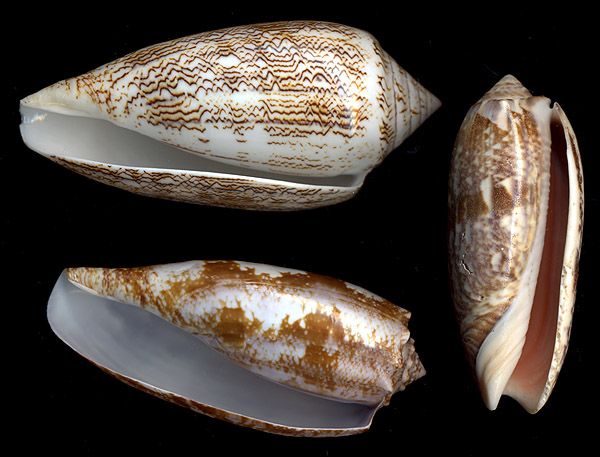
Above is a large cone of Textile, down is a geographical cone (shellfish is poisonous,
very thin shell), on the right is a small cone olive (very thick shell)
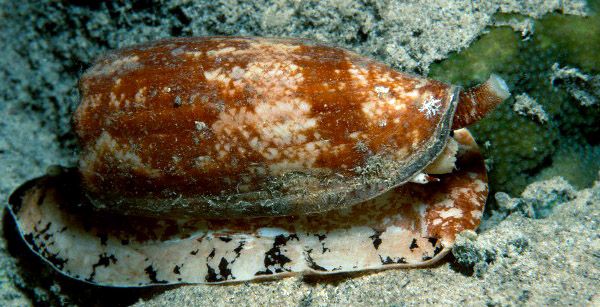
Information is used from a website https://nkj.ru
The safe shells of poisonous in nature shellfish are rotined - poison of cone Conidae is reminded by insulin, a cone dwells at-sea and often buries oneself in sand. Shellfishes of cones not recommended and it is forbidden to conduct in home terms and in the offices of firms, to hold in home aquariums, in artificial coral reefs and sandy beachs of house, and to use cones as home animals. Contain shellfishes of cones as having a special purpose work of the specialized enterprise on their breeding - the entrance of strangers there is usually forbidden.
Shellfishes of Conidae of one kind can have strongly differentiating poisons - general name of conotoxin. Another a feature of conotoxin is quickness of his action. It was also discovered that a toxin has different on the mechanism of action peptids, one of which immobilization, other anaesthetize et cetera It appeared the useful opening for pharmacology and medicine. For example, poison of shellfish of cone Conus magus is used for making of anaesthetic preparations is anaesthesia. Therefore to destroy and collect cones independently in any places, on coral reefs (preserves) and the more so on wild beachs and in aquatoriums it is categorically forbidden is can appear a farm on their breeding.
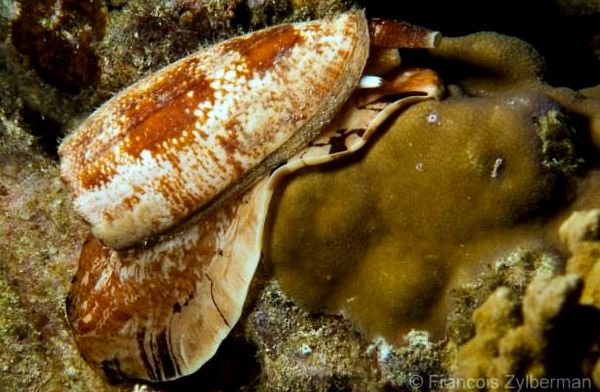
Poisonous shellfishes Cone (lat. Conidae geographus) is interesnye animals of tropical Maureies
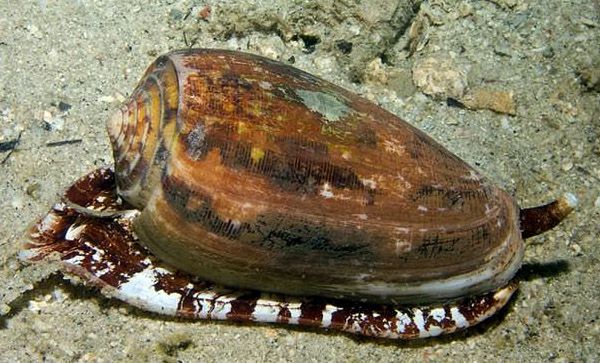
Information is used from a website https://ianimal.ru
About the cones Conidae - on materials of the Internet. Greater part of small cones Conidae is not dangerous for the grown man. Their poison is most typically intended for worms, other shellfishes and sometimes for finfishess. There is a few ten of types of cones, whose poison can cause pain or paralysis and result in death of man. The most poisonous are consider the next subspecieses of snails - geographical cone (Conus geographus), brocaded cone, tulip cone (Conus tulipa), marble cone and pearl cone. Poison of cones of conotoxin is investigational scientific B. Oliver - poison is presented by mixture of plenty of low-molecular peptids and containing 10–30 amino acid. An action is similar with the action of poison of cobra – he blocks the transmission of signal from nerves to the muscles. As a result numbness develops at staggered, death comes as a result of stop of human heart.
At least two types of snails of cones Conidae converted insulin into the weapon of submarine fight. When these water predators sneak up to the booty, they produce insulin is a hormone which compels sharply to fall level of sugar in blood, and shellfish eats the victim. Poisons of shellfishes of cones appeared various, unusual on an action and perspective for medicine (pharmacology). People product insulin in a pancreas, in shellfish insulin is produced in neuroendocrinal cages. Thus, that unexpectedly are two types of cones C. geographus and C. tulipa produce a hormone insulin in neuroendocrinal cages, and "weapon" - in a poisonous gland. A curious fact is insulin, found in cones, is the shortest molecular insulin. It is investigation of his high-specialized task – sharply and quickly to lower the level of sugar. The study of poison of shellfish of cone will help scientific in the receipt of medications for treatment of diabetes (coma - diabetic hypoglycemia). Information is used from a website https://pavelfedunov.livejournal.com.
Predatory cones, huntings on finfishess, kill the victim of insulinomas. Researchers from University of Utah (USA) analysed genes, encoding the toxins of cone C. geographus (geographical cone - most poisonous, he feeds on fish). Two types of genes of toxin of cone appeared look like insulin, thus in the poisonous gland of shellfish this pair of genes worked much more active than those, that responsible for usual toxic molecules. Further experiments rotined that poison of cone mainly consisted of insulin. Moreover, it turned out that shellfish imitated the hormone of finfishess, but not fully: molecule of "poisonous" insulin a few shorter than the real insulin of finfishess. Outpouring the "bucket of insulin" on fish, a cone immerses it in glucopenia shock, so that a victim almost loses ability to float and in general move. Except for C. geographus, insulin poison was found yet at Conus tulipa, which also feeds on fish. At cones, huntings on worms and shellfishes, insulin in a noticeable amount in the toxin "bouquet" of their poison discovering was not succeeded. Information is used from the website of magazine "Science and life" - http://nkj.ru.
Can amino acid of poison conotoxin of cones Conidae, contained in the toxin of shellfishes, abuse in sporting fitness gym and trainer halls sportsmen athletic bodybuilding and athlete for the increase of mass of their body, as by the element of the forbidden hormonal insulin sporting stimulant stimulant, performance-enhancing insulin drug dope nutrition of athleticism (contain a dangerous toxic hubbub insulin - C. geographus, C. tulipa and other). Numbness of body and death from the stop of human heart.
The favourite mestome of gasteropods snail whelk of shellfishes of Conidae is warm Large Barrier Reef at the banks of Australia. Geographical cone C. geographus is predatory nightly shellfish, hidden in in the day-time (in light time) in sand, in soft soil of bottom. Feeds on fish. Non-aggressive. Throws out the enormous doses of insulin, striking by him the victims with the purpose of eating up of victim. There are certain facilities which use in an order to neutralize poisons of living shellfishes of C. geographus and C. tulipa. As an antidote of poisoning insulin (extreme measure) can be used quick-dissolving sugar and to eat beforehand within resonable limits much sweet (if there is not diabetes), at a bite and defeat insulin to apply insulin intidoty and antidotes are hormones, selected at stress situations, adrenalin, glucose. Enter 1 cube see of preparation in the comatose consisting of patient of concentration 0,1%. From the body of postradavshego extract the poisonous tooth of shellfish and go out victim from the area of discharge cast of insulin in the water. On beachs with the cones Conidae does not bath is poison and Toxin dangerous coral cay reefs.
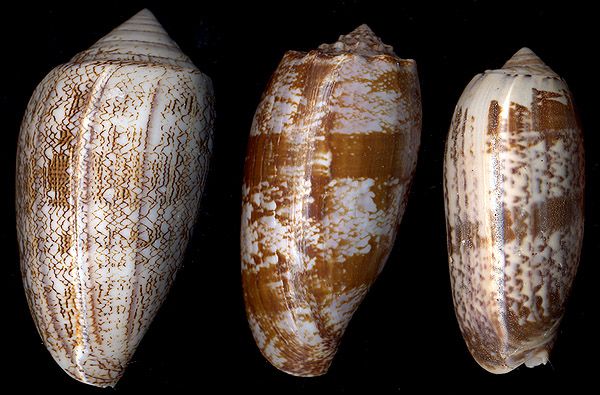
From left to right. Large cone of Textile, geographical cone, a small cone is an olive
Candlesticks and souvenirs are a section of website (shells). We offer to you the small and safe decorative collection shells of these most valuable and dear modern shellfishes without poisonous shellfishes in shells - in collection and for work. It is possible to adorn a home and office aquarium, fountain, small decorative artificial beach and coral reef of house the shells of cones Conidae and in an office, hotel, sanatorium, bureau office business place, park and public garden without the threat of poisoning of insulinomas (insuloma) - shellfish in a shell is not present. It is possible also to use the shells of Conidae for making of plaster casts of shellfishes of cones - in educational aims, for the advanced study, in private and museum collections, for a landscape design and exposition, shells are safe.
Toxin. Poisonous protein albuminous matters, being the products of metabolic of row of microorganisms microbe, and also some poisonous types of animals and plants, able to cause a disease or death of human or animal.
"Puka shell" - beads-like was so small pieces of seashell
Cones collection of Nickolay Doroshenko. In a center - Conus textile
Cones from collection of Nick Doroshenko. In a center - Conus textile Interesting information. "Puka shell" - the small beads-like pieces of marine seashell, polished in natural way by a surf wave exterminating (remaining durable frontal part of shell) on the beach sea-shores of the Hawaiian islands, were so named (The USA, Pacific ocean). Åheir frequent is used for making of necklaces and jewelry. These were the fragments of shells of seashell of cones (family of Conidae) taken away a sea, marked on a photo higher. Word "Puka" - in a translation a "hole" means from Hawaiian, that was implied as a natural opening is in a shell. On Hawaii of necklace from "Puka shell" and shells traditionally considered a talisman for success and protection in distant voyages. That tradition existed on the islands of Samoa, Fiji and other Cones (Conidae) are family of predatory whelk seashells which conduct a nocturnalism and in the day-time hide in sand. Shell of cone on a photo - from the north bank of island of Borakay. Collection of cones. Information is used from a website http://www.vitalysuper.com.
- Articles about a rare rosary from a stone, traditions and kinds beads as an art of XXI age
» Shambala, "knot of eternity" - the bangles of Shambala, lamaism of Tibet, Kailas
» Komboloi greek for turning - original type and class man beads
» A christian and buddhistic rosary is christianity, buddhism, islam, flat throw rosary
» Moslem rosary, christianity and other rare types of different rosary
» Buddhistic rosary, Krishna worship is a bone of bull, cow, mother of pearl, pearls
» Beads, a brief review is beads is history and traditions (Internet materials)
» Lava stone, lava of volcano, volcanic bombs are a fashion, SPA and litotherapy
» Bianstone sibin is a black petuntse as material for massager of guasha
» Blue glina, dark blue clay and vivianite is litotherapy compresses, source of radium
» Cherri quartz, Fiery Quartz, Strawberry Quartz, cherry, red quartz
» Rudraksha are seed of tree of Indo-Ganges of plain and foot-hills of Himalayas, beads
» Lotus, seed of lotus are character of deities of India and medical plant, beads
» Bone of bull and cow is fashionable material for modern jewelry, bijouterie
» Shells of shellfishes and cones are inhabitants of coral reefs, beachs and Maureies
» Corals and coral reefs are pictures of corals and coral reefs in nature
» Salt lamps and salt are natural galit, salt therapy and speleotherapy at home
» Luminescence of stone is a LED flashlight for diagnostics of stone, luminescence
» Dreamcatcher (disambiguation) is a talisman of north-american American Indians and Siberian nationalities
» To sale "Dreamcatchers" is the finished products, with stone, feathers, making under an order

